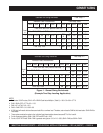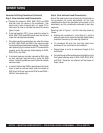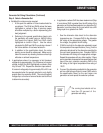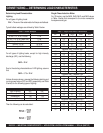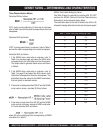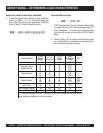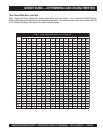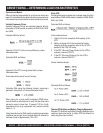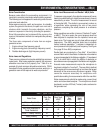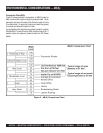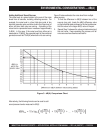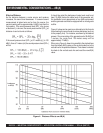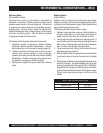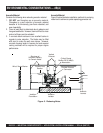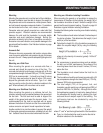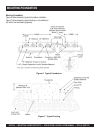
INDUSTRIAL GENERATOR SETS — APPLICATION & INSTALLATION MANUAL — REV. #4 (09/07/07) — PAGE 27
ENVIRONMENTAL CONSIDERATIONS — dB(A)
Noise Consideration
Because noise effects the surrounding environment, it is
important to consider noise factors when installing a genset.
The following is a brief approach to evaluating noise sources
and noise level reduction.
Noise requires a source, a path, and a receiver. In a standby
system, the genset is the source, the path is air or air and a
structure which transmits the noise vibrations, and the
receiver is a person in the vicinity (including the operator).
Since little prevention can be done with the source or the
receiver, the treatment method is to manipulate the pathway
of noise.
The three main components of noise from an engine-
generator set are:
1. Engine exhaust (low frequency sound)
2. Engine moving parts (low and high frequency sound)
3. Radiator discharge air (high frequency sound).
Noise Laws and Regulations
There are many state and local codes establishing maximum
noise levels. Most noise regulations specify the maximum
allowable noise level at the property line. Table 8 is an
example of typical maximum allowable noise levels. OSHA
has specific noise regulations where persons working in a
generator room will be required to wear ear protection.
sleveLesioNedistuOrofairetirClacipyT.8elbaT
senoZesioN
yaDkaeP
)A(Bd
thgiNkaeP
)A(Bd
suounitnoC
yaD
)A(Bd
suounitnoC
thgiN
)A(Bd
laitnediseR—nabrU26257574
laitnediseR—nabrubuS75742524
ronabrubuSetiuQyreV
laitnediseRlaruR
25247473
yrtsudnIybraeN—nabrU76752625
yrtsudnIyvaeH27267675
Noise Level Measurement and Decibel / dB(A) Units
To measure noise properly, the subjective response of human
hearing is substituted by an objective measurement of sound
measured by a meter. The unit of measurement for sound
is the decibel (dB). The decibel is a convenient number on
a logarithmic scale expressing the ratio of two sound
pressures, comparing the actual pressure to a reference
pressure.
Noise regulations are written in terms of "decibels 'A' scale"
or dB(A). This term means the sound pressure level has
been adjusted to duplicate how the imperfect human ear
hears noise. The human ear can only hear within a range of
frequencies. The dB(A) weighted scale tries to simulate
human loudness perception. Loudness is dependent on
sound pressure level (amplitude) and frequency. See Figure
2 on page 28 for a dB(A) comparison.
Decibel tests are conducted in a "free field". A free field is
a sound field in which the effects of obstacles or boundaries
on sound propagated in the field are negligible. A "reverberant
field" is a sound field in which the effects of obstacles or
boundaries on sound propagated in the field are not negligible.
Accurate noise measurements require the microphone to
be placed outside the "near field". The near field is defined
as the region within one wavelength or two times the largest
dimension of the noise source, whichever is greater. Noise
cannot be measure accurately for compliance with
specifications calling for measurements within the near field.
Noise measurements should be made using a sound level
meter and octave band analyzer. The microphones should
be placed in a circle of 23 feet (7 meters) radius centered on
the generator set.



